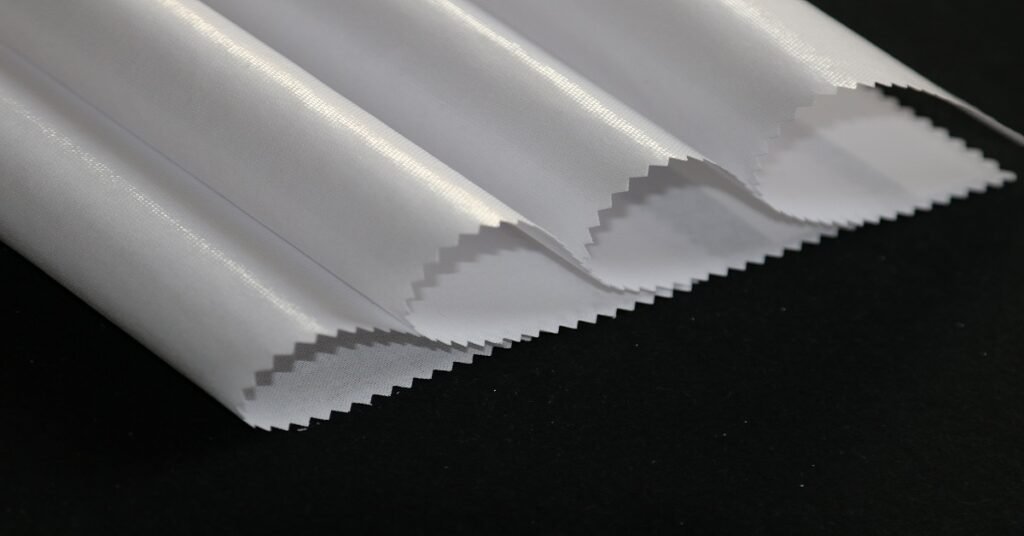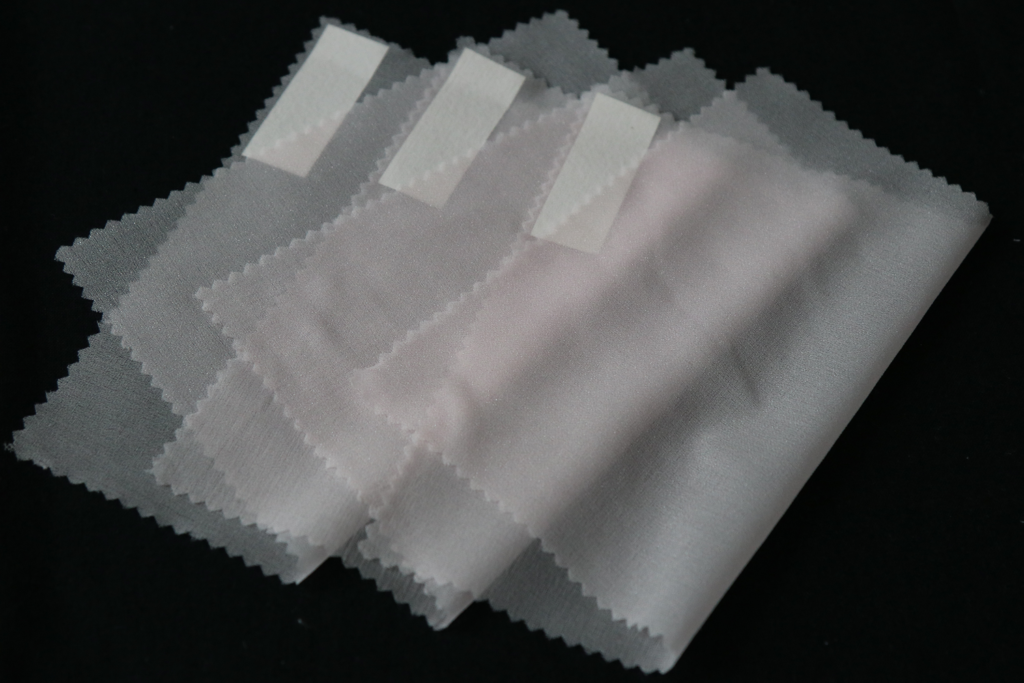Introduction
Imagine your favourite hoodie or dress – something special inside makes it comfy and keeps its shape. That special thing is called “interlining,” we’re here to talk about why some are better than others in simple terms.
Quality standards are like rules that interlining must follow to be good. It’s about ensuring interlining works well, like holding fabrics together and ensuring your clothes stay nice for a long time. We’ll check out different types of interlining and learn what makes one better. We’ll discuss how heavy it is and whether it can handle washing without fuss.
So, get ready to discover why some interlinings are super cool and why they matter for your clothes. We’ll make it easy to understand – promise! Let’s find out what makes interlining awesome together!

What Types of Interlining Exist?
Fusible Interlining:
Fusible interlining is like the glue that holds your fabric together. It has a special coating that sticks when you heat it. You’ve probably seen it in things like collars or cuffs. It makes them crisp and neat. Think of it as a heat-activated buddy for your fabric.
Characteristics
It sticks when heated, like fabric glue.
Applications
Perfect for collars and cuffs where you need that crisp look.
Sew-In Interlining
Now, sew-in interlining is more like a supportive friend. It doesn’t stick; you sew it into the fabric. This one is great for delicate fabrics that might not like the heat of fusible interlining. It gives them the extra support they need without the sticky situation.
Characteristics
No sticking; sew it into the fabric for extra support.
Applications
Ideal for delicate fabrics that can’t handle the heat.
Knitted and Woven Interlining
Let’s talk about how the interlining is made. It can be knitted, like your grandma’s scarf, or woven, like your jeans. Knitted interlining is stretchy and good for flexible clothes, while woven interlining is sturdy and perfect for structured pieces.
Differences
Knitted is stretchy, like a yoga class for fabrics. Woven is sturdy and structured, like a well-built house.
Suitability
Knitted for flexible clothes, woven for more rigid pieces.

Key Characteristics: What Constitutes High-Quality Interlining?
Material: Choosing Teammates
Interlining can be made from cotton (from plants) or wool (from sheep), giving a natural touch. Others use synthetic stuff, like polyester, adding a bit of tech power. You can also mix them.
Weight and Thickness: Getting the Right Feel
Interlining is like the thickness of a superhero cape. Match it to your clothes so it feels right – not too heavy or light.
Sticking Power: Making Friends with Heat
Some interlinings stick to the fabric when you heat them. Others, like sew-in ones, don’t stick but help by being sewn in.
No Shrinking Allowed: Clothes That Stay the Same
Good interlining laughs at the idea of clothes shrinking after a wash. It ensures your clothes always fit perfectly.
Tough Clothes: Ready for Anything
Imagine your clothes are soldiers, and interlining is their armour. The good interlining makes sure that armour lasts through many washes.
Colours that Last: Keeping the Vibes Alive
High-quality interlining prevents clothes from losing colour after a few washes. It’s like a colour protector, making sure your clothes stay bright.
Rules and Certificates: Meeting Standards
Global rules like Oeko-Tex Standard 100 and REACH Regulations ensure your interlining is safe and has no harmful stuff.
Trustworthy Allies: Choosing Good Partners
Good interlining comes from trustworthy makers and sellers. They make sure your clothes get the best sidekick for a fantastic look.

Performance Standards: What Should Interlining Withstand?
Shrinkage Resistance: No Laundry Surprises
Good interlining resists shrinking after a wash. It’s like having a superhero suit that always fits, no matter how often it hits the laundry.
Durability and Washability: Tough Armor
Your clothes are like soldiers, and interlining is their armour. High-quality interlining ensures that armour lasts through many washes. It’s about having sharp clothes after repeated spins in the washing machine.
Colorfastness: Vibrant Hues
High-quality interlining prevents your clothes from losing colour after a few washes. It’s like a colour protector, keeping your clothes vibrant and true to their original colours.
Industry Regulations and Certifications: Following the Rules
High-quality interlining follows rules like Oeko-Tex Standard 100 and REACH Regulations. It ensures your interlining is safe and free from harmful substances. It’s like having a badge that says, “This interlining is top-notch and safe for you and the environment.”
Certified Manufacturers and Suppliers: Trustworthy Partners
Choosing to interline is like assembling a superhero team. High-quality interlining comes from trustworthy makers and sellers. They ensure your clothes get the best sidekick for a fabulous outcome. Choosing reliable partners is key to getting the best out of your interlining.
Industry Regulations and Certifications: Are They Necessary?
Global Standards: Keeping Things Safe
Global standards, like Oeko-Tex Standard 100 and REACH Regulations, are the rules everyone follows. They make sure that the stuff used to make interlining is safe. It’s like a promise that what you’re getting won’t harm you or the environment.
Making Sure Manufacturers Follow the Rules
For the people who make interlining, following these rules is a must. It’s not just about doing what you’re told; it’s about making safe materials for people and the planet. Following these rules is like having a stamp that says their interlining is top-notch and safe.
Knowing Where Things Come From: Keeping it Clear.
Certifications also help us see where things come from. Manufacturers need to know where their materials come from and how they’re made. This clarity ensures that every step, from the beginning to the end, follows the rules. It’s about making sure the journey of interlining is safe and clean.
Being Friendly to the Earth: Going Green
Nowadays, being kind to the planet is a big deal. Certifications like REACH not only focus on safety but also on being nice to the environment. For manufacturers, this means choosing interlining that doesn’t hurt the Earth. It’s about making eco-friendly choices for a greener textile world.
Helping You Choose Wisely: Confidence in Your Buy
These certifications are like guides for us, the people who wear clothes. When you see Oeko-Tex or REACH certifications, the interlining in your clothes meets high standards. It’s like a thumbs-up, telling you you’re making a smart choice. Certifications help you pick products that are safe and good for the environment.

Innovations in Interlining Technology: What’s Next?
Green Choices: Using Earth-Friendly Stuff
Interlining’s future is all about being eco-friendly. Manufacturers are checking out materials and ways of making them that are kind to our planet. It’s like whipping up interlining in a way that’s good for Mother Earth, like using nature-friendly ingredients for a recipe.
Less Waste: Interlining That Goes Away
Here’s a cool idea – making interlining that can break down or get recycled. It’s like having interlining that doesn’t stick around forever, helping us make less waste. Manufacturers are figuring out ways to make interlining vanish in a friendly way when it’s no longer useful.
Smart Clothes: Tech in Your Wardrobe
Imagine interlining; that’s smart! Manufacturers are thinking about ways to put tech into interlining. It’s like having clothes that do more than just cover you up. Picture interlining with smart features, making your clothes as cool as your gadgets.
Eco-Friendly Colors: Making Colors Stick Nicely
Sometimes, making colours stick to interlining isn’t nice for our planet. Manufacturers are testing out ways to dye interlining that are eco-friendly. It’s about keeping your clothes full of colour without hurting the Earth.
Better Sticking Power: Glue That Works Even Better
In the future, interlining might get even better at sticking. Manufacturers are figuring out ways to make interlining stick to fabrics more effectively. It’s like upgrading the glue, making sure it holds everything together super well.
Fighting Germs: Interlining That Keeps Things Clean
Imagine interlining that fights off germs. Manufacturers are looking into ways to add things to interlining that keep things clean and healthy. It’s like having clothes that look good and stay germ-free.
Smart Making: Faster and Smoother Production
Manufacturers are using smarter ways to make interlining. It’s about using faster and smoother processes to meet the demand. Picture it like upgrading from a regular kitchen to a high-tech one – faster, smoother, and more efficient.
Affordable Quality: Great Stuff That Doesn’t Cost a Lot
In the future, they’re looking into making top-notch interlining that doesn’t cost too much. It’s like having a really good meal that’s also easy on the wallet. Manufacturers are finding ways to give us fantastic interlining without breaking the bank.
Challenges in Maintaining Quality Standards for Interlining: What Hurdles Exist?
Making Sure Things Stay the Same: Consistent Materials
A big challenge is ensuring the ingredients used to create interlining don’t change. It’s like baking a cake and wanting it to taste the same every time – using the same good stuff is key.
Balancing Between Making a Lot and Keeping it Good: Meeting High Demand
Manufacturers face the task of making more interlining to meet the demand without making it less good. It’s like cooking for a big party and still wanting each dish to be delicious – finding the right mix is important.
Checking Everything: Making Sure it’s Good Every Time.
Checking and double-checking is crucial. Manufacturers must inspect each batch of interlining to ensure it meets the set standards. It’s like tasting every pizza to ensure they’re all as tasty as the first one.
Keeping Up with New Stuff: Using Better Technology
Staying updated with new technologies is another challenge. Manufacturers need to adapt to these changes to improve how they make interlining. It’s like switching from an old phone to a faster, newer one – keeping up with the times is necessary.
Thinking About the Environment: Balancing Good Quality and Doing Right by Nature
Balancing quality and being kind to the environment is tough. Manufacturers must make good choices that don’t harm the planet but keep the interlining top-notch. It’s like choosing a path that ensures great interlining while being good to Mother Earth.
Quality Standards for Interlining: Conclusion
Quality standards for interlining are like rules to ensure your clothes are top-notch. They check if the materials are safe, won’t shrink, and keep colours vibrant. Following standards means your clothes look good, feel comfy, and last longer.
It’s like a stamp saying, “This interlining is awesome and safe for you and the Earth.” So, when you pick clothes with high-quality interlining, you’re choosing the best for a stylish and reliable wardrobe. It’s about making sure your outfits are not just cool today but stay cool wash after wash.
Quality Standards for Interlining: FAQs
What Are the Characteristics of Interlining?
Interlining adds strength and shape to clothes, with variations in weight, thickness, and adhesive properties to suit diverse garment needs.
What Are the Quality Standards for the Textile Industry?
Textile standards, like Oeko-Tex and REACH, ensure fabrics are safe, eco-friendly, and meet global regulations, promising quality and reliability.
What Material Should I Use for Interlining to Maintain Quality Standards?
Choose interlining material based on needs. Cotton and wool give a natural feel, while synthetics like polyester add technical strength. Mixing options is also common for varied benefits.
Contact Us today to purchase the interlining with most effective interlining.

